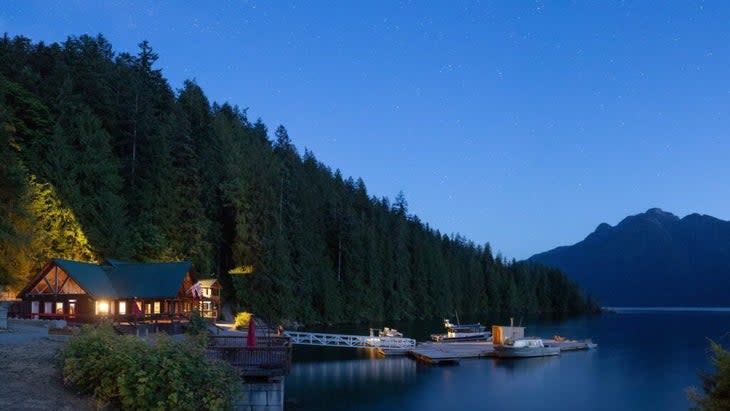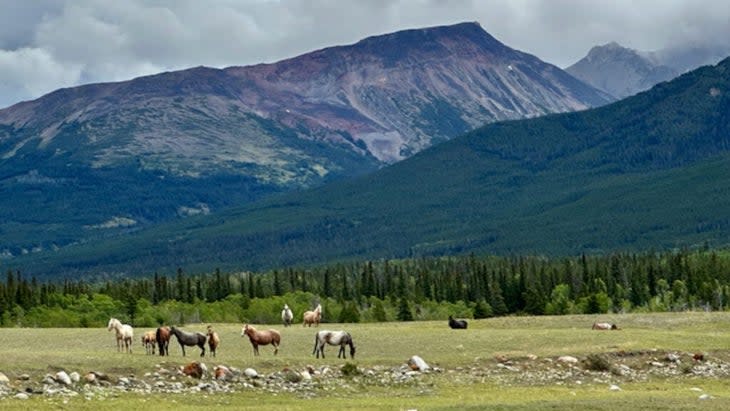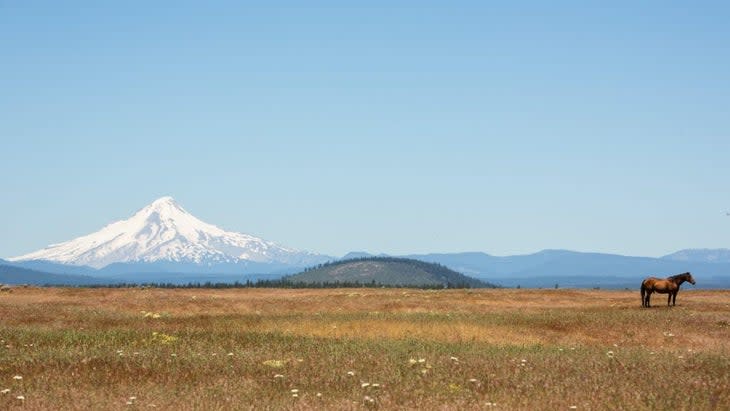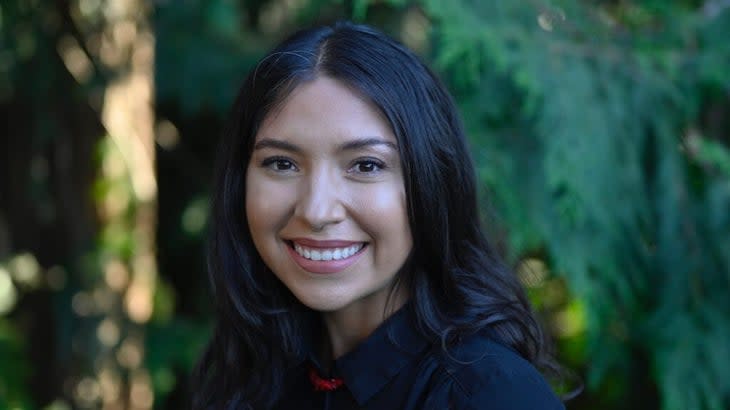5 Stunning Native-Owned Resorts in the West
This article originally appeared on Outside
Ever come across an incredible hotel that stops you mid-scroll and makes you think, Wow, wouldn't it be something to stay there? We do, too--all the time. Welcome to Friday Fantasy, where we highlight amazing hotels, lodges, cabins, tents, campsites, and other places perched in perfect outdoor settings. Read on for the intel you need to book an upcoming adventure here. Or at least dream about it.
Growing up, I couldn't help but notice a stark absence of my ancestors' presence in outdoor spaces. In Grand Teton National Park, Wyoming, there was no visible trace of the Eastern Shoshone, despite stories I'd heard about those mountains' significance to my tribe. While there has been progress in recent years to better include Indigenous people in conservation and outdoor communities, we remain obscured and often misrepresented in North America, which is why when outdoor enthusiasts seek recommendations of where to stay, I advocate for tribal-owned properties.
Native communities possess an unparalleled understanding of their natural landscapes, and visiting a tribal-owned lodge or hotel is an invitation to gain an understanding of their wisdom and the ongoing cultural significance of their homelands in an authentic way. It's a holistic experience: you can enjoy locally sourced, traditional foods (like fresh sockeye salmon), wellness amenities that may incorporate traditional medicines and remedies (cedar salves), and art and architecture that reflect accurate depictions of their heritage (carvings and beadwork).
Additionally, many Native-owned properties stand out as the epitome of environmental sustainability, so by staying at them you're making an eco-conscious choice. And not least, you can feel good about supporting Indigenous small businesses and tribal economies, which have historically been disenfranchised from large-scale development.
The following five tribal-owned properties are all excellent examples of unique stays in the western U.S. and Canada.
Klahoose Wilderness Resort, British Columbia
Owned by Klahoose First Nation

The four-lodge and two-cabin Klahoose Wilderness Resort, accessible only by boat or seaplane from the village of Lund (123 miles north of Vancouver), promises an off-grid experience from its island base on Desolation Sound, a place renowned for its stunning beauty--the emerald waters of the Homfray Channel are home to all kinds of marine creatures, and the Coast Mountains rise up sharply to 13,000 feet.
Explore remote inlets by boat, passing cascading waterfalls from ancient glaciers and, if you're lucky, witnessing the majesty of humpback whales. Knowledgeable Klahoose guides will generously share their cultural heritage, stories, and language, weaving a rich tapestry of the land’s history and significance. From May through June and again from August through October, you can sign up for guided grizzly bear-viewing tours; groups of no more than 12 are transported first over the water and then by bus to six Klahoose riverside platforms for an intimate encounter with these powerful animals.
But bears aren't the only wild things roaming these lands; you’ll likely spot orcas, dolphins, sea lions, and bald eagles during a trip here, even from the resort's dock. While the resort is closed now, book ahead for stays in 2024; the property will welcome guests between May 9 and October 23.
To book: KlahooseResort.com
Price: From $2,495 per person for three nights stay, including all meals, select tours, and transport to and from Lund
Salish Lodge and Spa, Washington
Owned by the Snoqualmie Tribe

Located 35 miles east of Seattle in the North Cascade Mountains, this 86-room lodge is perched on a hillside that overlooks the sacred 268-foot Snoqualmie Falls. The Snoqualmie believe its mist conveys prayers up to their ancestors, one of the reasons the tribe is trying to safeguard its protection in the face of the more than 1.5 million annual visitors. Known as an oasis of rejuvenation, guests tend to visit Salish for its restorative amenities, be it a few nights in mountainside or riverside rooms, each with its own gas fireplace, or spa treatments that use honey made from the on-site apiary and facials that incorporate locally sourced ingredients like snow mushrooms, birch water, and reishi mushrooms.
To learn about Snoqualmie culture, visit the newly renovated gift shop and visitor center, which features informational installations, art by Snoqualmie artists, and a video about the tribe’s history and ancestral land. If outdoor adventure is more your speed, I can recommend several hiking trails that wend along paths through Douglas firs and red cedars; the easiest is a 0.4-mile trail to the lower falls, but for something challenging, head about 20 minutes from the lodge to the Mailbox Peak Trailhead for a ten-mile out-and-back trek.
To book: SalishLodge.com
Price: From $250
Hotel Santa Fe, New Mexico
Owned by Picuris Pueblo

This is the only Native-owned hotel in New Mexico’s state capital. Guests are drawn to the 161-room property's adobe architecture and central location, convenient to the burgeoning Railyards District, just a ten-minute walk from the downtown plaza, and minutes from all kinds of outdoor adventures in the area. Staff can book guided horseback rides through pinon trees and desert arroyos, winter transportation up to the 660-acre Ski Santa Fe, 16 miles away, and captivating tours of Picuris Pueblo, 60 miles north of town in the Sangre de Cristo Mountains.
Prefer to forge your own path but do so while learning about local Indigenous culture? Head to Bandelier National Monument, 40 miles northwest, to explore the ancestral Pueblo village of Tsankawi; a 1.5-mile loop trail skirts past cave dwellings and petroglyphs, allowing you to walk the pathways shaped by Pueblo ancestors nearly a millennium ago. Although always popular, if you're intent on coming for the Southwestern Association for Indian Arts' Santa Fe Indian Market in August, secure your reservation well in advance.
To book: HotelSantaFe.com
Price: From $109
Nemiah Valley Lodge, British Columbia
Owned by Xeni Gwet'in, part of the Tsilhqot'in Nation

Immerse yourself in the culture of the Xeni Gwet'in, traditional stewards of the Nemiah Aboriginal Wilderness, a 4,944-square-mile area home to one of North America's last remaining wild-horse preserves. Xeni ambassadors will lead you to see them (and explain how the Xeni Gwet'in have managed them for hundreds of years) as well to other special parts of their lands; you might opt for a road trip to Chilko Lake, Canada's largest natural high-elevation freshwater lake, or a memorable paddle-and-hike excursion to explore a Gwet'in traditional village site.
Your journey here is a testament to preserving nature’s beauty--logging, mining, road construction, and dam development are all prohibited here--and honoring Indigenous heritage. Off-grid lodging is nestled within the wilderness and relies on solar energy to power its seven two-bedroom log cabins, each a unique showcase for art and photography thoughtfully curated from local Indigenous talents. Meals are created with ingredients sourced nearby and could include traditional foods like fire-cooked bannock, pine-bark-sugar-infused lake trout, and roasted root vegetables grown on the grounds. Nemiah is open from June to October and is located about 110 miles west of the town of Williams Lake.
To book: NemiahValleyLodge.com
Price: From $2,175 per person for three nights, all-inclusive
Kah-Nee-Ta Hot Springs Resort, Oregon
Owned by the Warm Springs Tribe

Set on the eastern edge of the Warm Springs Indian Reservation, 95 miles southeast of Portland, Kah-Nee-Ta basks in the sun’s glow for an impressive 300 days a year. Originally opened in 1962, tough economic times caused it to close in 2018, but a major renovation is nearly complete and it's scheduled to open next year. Plans include brand-new mineral pools, 30 remodeled guest rooms, 20 tepees, 70 RV spots, and a revived resort experience.
The crown jewel of Kah-Nee-Ta is its outdoor mineral soaking pools, naturally sourced from springs with temperatures that range from 92 to 104 degrees and renowned for therapeutic properties. You can spend the day adventuring and then ease into waters that provide relief to tired joints and muscles or nurture sensitive skin. The property will also welcome guests with new access to a three-mile stretch of the Warm Springs River, where you can kayak, float, or enjoy a half- or full-day guided fishing tour or class. For those seeking a deeper connection to the land and its Indigenous people, Kah-Nee-Ta is expected to offer a cultural heritage center, village craft market, and traditional weekend salmon bakes.
To book: KahNeeTa.com
Price: Price still to be determined

Savannah Romero is the director of communications at Tahoma Peak Solutions, a Native woman-owned firm focused on empowering Native communities. She is also a poet and an MFA creative-writing student at the Institute of American Indian Arts. She loves the Pacific Northwest and the Salish Sea, where she grew up, as well as the Wind River Mountain Range, which are her ancestral homelands.
For exclusive access to all of our fitness, gear, adventure, and travel stories, plus discounts on trips, events, and gear, sign up for Outside+ today.

